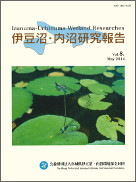Volume 8
Displaying 1-8 of 8 articles from this issue
- |<
- <
- 1
- >
- >|
-
2014 Volume 8 Pages 1-15
Published: 2014
Released on J-STAGE: November 10, 2017
Download PDF (1207K) -
2014 Volume 8 Pages 17-21
Published: 2014
Released on J-STAGE: November 10, 2017
Download PDF (519K) -
2014 Volume 8 Pages 23-34
Published: 2014
Released on J-STAGE: November 10, 2017
Download PDF (1139K) -
2014 Volume 8 Pages 35-43
Published: 2014
Released on J-STAGE: November 10, 2017
Download PDF (893K) -
2014 Volume 8 Pages 45-50
Published: 2014
Released on J-STAGE: November 10, 2017
Download PDF (750K) -
2014 Volume 8 Pages 51-55
Published: 2014
Released on J-STAGE: November 10, 2017
Download PDF (673K) -
2014 Volume 8 Pages 57-66
Published: 2014
Released on J-STAGE: November 10, 2017
Download PDF (1079K) -
2014 Volume 8 Pages 67-70
Published: 2014
Released on J-STAGE: November 10, 2017
Download PDF (412K)
- |<
- <
- 1
- >
- >|
